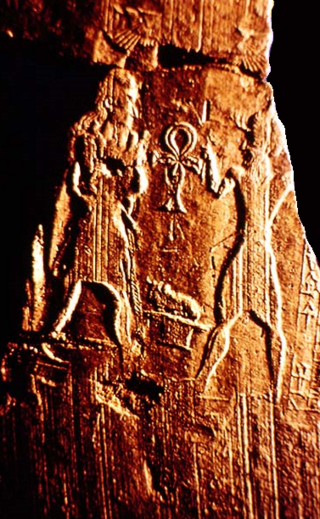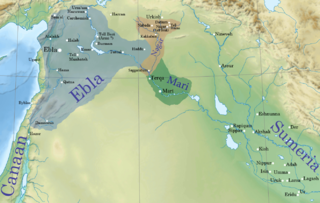
Ebla was one of the earliest kingdoms in Syria. Its remains constitute a tell located about 55 km (34 mi) southwest of Aleppo near the village of Mardikh. Ebla was an important center throughout the 3rd millennium BC and in the first half of the 2nd millennium BC. Its discovery proved the Levant was a center of ancient, centralized civilization equal to Egypt and Mesopotamia and ruled out the view that the latter two were the only important centers in the Near East during the Early Bronze Age. The first Eblaite kingdom has been described as the first recorded world power.

Mari was an ancient Semitic city-state in modern-day Syria. Its remains form a tell 11 kilometers north-west of Abu Kamal on the Euphrates River western bank, some 120 kilometers southeast of Deir ez-Zor. It flourished as a trade center and hegemonic state between 2900 BC and 1759 BC. The city was built in the middle of the Euphrates trade routes between Sumer in the south and the Eblaite kingdom and the Levant in the west.
Irkab-Damu was king (Malikum) of the first Eblaite kingdom, whose era saw Ebla's turning into the dominant power in the Levant.
Ibrium, also spelt Ebrium, was the vizier of Ebla for king Irkab-Damu and his successor Isar-Damu.
Damu was a Mesopotamian god. While originally regarded as a dying god connected to vegetation, similar to Dumuzi or Ningishzida, with time he acquired the traits of a god of healing. He was regarded as the son of the medicine goddess Ninisina, or of her equivalents such as Gula or Ninkarrak. It is unclear which city was originally associated with him, but he is best attested in association with the cult center of his mother, Isin.

Hamazi or Khamazi was an ancient kingdom or city-state which became prominent during the Early Dynastic period. Its exact location is unknown.
Tudiya or Tudia was according to the Assyrian King List (AKL) the first Assyrian monarch, ruling in Assyria's early period, though he is not attested in any known contemporary artefacts. He is listed among the “seventeen kings who lived in tents.” His existence is unconfirmed archaeologically and uncorroborated by any other source. According to the list, Tudiya was succeeded by Adamu.
Armi, was an important Bronze Age city-kingdom during the late third millennium BC located in northern Syria, or in southern Anatolia, Turkey, at the region of Cilicia.
Hassum was a Hurrian city-state, located in southern Turkey most probably on the Euphrates river north of Carchemish.

Indilimma, previously read Indilimgur, was likely the last king of Ebla, in modern Syria, reigning around 1600 BCE.
Vizier, is the title used by modern scholars to indicate the head of the administration in the first Eblaite kingdom. The title holder held the highest position after the king and controlled the army. During the reign of king Isar-Damu, the office of vizier became hereditary.
Kun-Damu was a king (Malikum) of the first Eblaite kingdom ruling c. 2400 BC. The king's name is translated as "Arise, O Damu". Kun-Damu is attested in the archives of Ebla dated two generations after his reign. According to Alfonso Archi, he was a contemporary of Saʿumu of Mari. The archives of Ebla records the defeat of Mari in the 25th century BC, and based on the estimations for his reign, Kun-Damu might be the Eblaite king who inflicted this defeat upon Mari. Aleppo might have came under the rule of Ebla during his reign. Following his death, he was deified and his cult was attested in Ebla for at least 30 years after his reign.
Ishtup-Ishar (Ištup-Išar) was a king (Lugal) of the second Mariote kingdom. The king's name was traditionally read as Išhtup-šar, with šar being a common divine element in personal names attested in the region. However, the king's name is read as Ishtup-Ishar by Alfonso Archi, Ishar being an important justice deity worshiped in Mari and Ebla.
Isar-Damu, was the king (Malikum) of the first Eblaite kingdom. Isar-Damu fought a long war with Mari which ended in Eblaite victory; he was probably the last king of the first kingdom.
Abarsal was a city-state of Mesopotamia in the area of the Euphrates. Very little is known of the history of the town and the site is unidentified at the moment. It could be the city of Aburru mentioned in various texts of the tablets of Mari, which was located south of Emar to Qalat Gabir. A second theory says that could be Apishal.

Igrish-Halam or Igriš-Halab was a king of the ancient city state of Ebla. His name means "(The god of) Halab has driven away ", hence, the name might be a commemoration of an Eblaite victory that led to the incorporation of lands beyond the city of Halab.
Ib'al was the name used by Ebla in the 24th century BC to indicate a confederation of tribes occupying the steppic region south of Ebla; the region included small villages and towns. Qatna could have been one of the urban centers in the region.
Hadabal was a god worshiped in Ebla and its surroundings in the third millennium BCE. He was one of the main gods of that area, and appears frequently in Eblaite documents. His character is not well understood, though it has been proposed that he might have been an agricultural or lunar god. Like the city's tutelary god Kura and his wife Barama, he is absent from sources postdating the destruction of Ebla.
Kura was a god worshiped in Ebla in the third millennium BCE. He was the tutelary god of the city, as well as the head of the local pantheon. While his functions are difficult to ascertain, it is well attested that he was connected to the institution of kingship.
Barama was a goddess worshiped in the Syrian city of Ebla in the third millennium BCE as the wife of its tutelary god, Kura. She is not attested from any sources postdating the destruction of the city.




